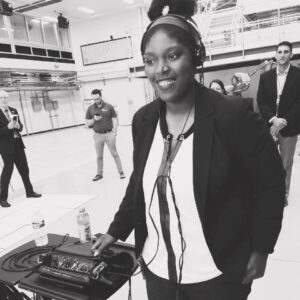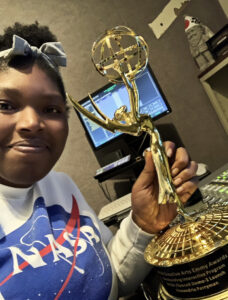
Alexandria Perryman – Audio Engineer for the Astronauts
Alexandria Perryman is a live broadcast engineer and Emmy winner working at NASA’s Johnson Space Center, where one of her jobs is to run audio for the astronauts on the International Space Station. Every “Mission” is different for her. One day she might be working a spacewalk, making sure the astronauts have a clear connection to mission control the next she might be mixing audio for a video that’s going up on the NASA YouTube channel.
Lately, she’s been working to provide Skype links between astronauts and students. The effort is part of NASA’s “Year of Education on Station” – a program where ISS crew members and teacher Ricky Arnold Skypes in via satellite and performs real-time experiments for kids in classrooms around the country.
Alexandria discovered audio when she was in her high school’s marching band and was put in charge of the on-field sound mixer. This is where she started to fall in love with the idea of live audio mixing. She always had a passion for music and sound and as she got older she became intrigued by how music and sound are created. She remembers seeing Blue Man Group perform when she was in elementary school and being in awe with how they used everyday items to create music. Alexandria would enroll at Full Sail University and study audio engineering and graduate in 2015 with an Associates Degree of Science.
She got her start in audio volunteering at her church, mixing their online broadcast and working part-time as an AV Tech. Early on she learned how important troubleshooting quickly is and learned how to work in fast-paced and high-stress situations. She says “I made many mistakes in those early gigs but I was in an environment where if I could troubleshoot my mistakes quickly then it was not harmful to my career.”
She has been at NASA working as an Audio Engineer and Chief Engineer and Producer of  Podcast for the last 2 ½ years. Alexandria says there is no typical day at NASA.
Podcast for the last 2 ½ years. Alexandria says there is no typical day at NASA.
“The workday starts for me an hour before my first show which sometimes could be at 3 am. Then there is the podcast that I produce weekly and studio shoots. It is common for me to go day by day.” Staying focused and organized is difficult Alexandria says “I may have a live event then an hour later I am recording a podcast, two different mindsets. Staying focused on the task I am doing at that time is super important.”
Some of Alexandria’s job duties are coordinating Skype signals in space and she is proud that during her time at NASA her team has never lost a Skype signal in space. Mission Planning and Operations works with her team to find optimal windows between satellites and schedule sessions accordingly.
Alexandria also works on archiving and preserving audio for the historical record and the U.S. National Archives. The crew of the ISS rotates every six months and NASA will use this audio for training new crew members and for reference on repeat problems. Alexandria with other engineers monitors the day to day operation recordings and are often the first line of communication between station and NASA. She often works with the astronauts before missions, she is the one mic-ing them up for interviews and trains them on using the audio equipment.
In addition to all of her official duties, Alexandria also serves as the producer of NASA’s official podcast Houston We Have a Podcast. The podcast talks with and interviews astronauts, scientists, and engineers working on furthering space exploration.
Alexandria says she loves that her job allows her to be part of something bigger than herself, but is not a fan of how politics come into play with what she does as a creative. She is awaiting NASA’s return to the moon and hopes to be able to mix the audio. Her long term goals are to mix audio for the Grammys.
On Challenging Projects
One challenge that sticks out the most was the Space X Demo-1 mission. It was  challenging because it was the first time we ever merged our NASA shows with SpaceX. Learning how to coordinate a show between multiple locations and have it flow easily was definitely difficult. The audio setup was new and extremely complicated but as a team, we managed to put out great shows for that mission. It’s also the same mission I won my first Emmy for.
challenging because it was the first time we ever merged our NASA shows with SpaceX. Learning how to coordinate a show between multiple locations and have it flow easily was definitely difficult. The audio setup was new and extremely complicated but as a team, we managed to put out great shows for that mission. It’s also the same mission I won my first Emmy for.
On Failure
For me looking back the biggest failure, I had happened in college. I had become lazy with class and my grades quickly fell, to the point that I was put on academic probation. That was a big wake up call for me, because if I had failed another class I would have failed out of college. In the next couple of months, I kicked it in gear and studied more, went to my instructors during office hours for extra help, and surrounded myself with positive people. I learned from that experience to never slack off and always do my best. Most importantly I learned that even when the odds are against me that I can overcome anything as long as I never stop trying.
What if any obstacles or barriers have you faced?
I have been fortunate to not have faced many obstacles or barriers in my career. The only thing that was an obstacle was having such an age gap between my coworkers and them being able to trust that I’m mentally capable of the job regardless of my age.
How have you dealt with them?
Earning trust takes time especially in this industry. I was able to do it by constantly giving them my best work and attitude and showing up in big situations.
Advice you have for other women and young women who wish to enter the field?
Don’t be afraid to make mistakes, that’s the only way you can really learn. Some of the biggest mistakes in my career offered me the most valuable lessons.
What is your favorite day off activity?
While I work in live television and not the music industry, I still love creating music in my free time as a way to express my emotions.
Must have skills?
Must be able and willing to be teachable at any level. Also for anything-audio understanding signal flow is key.
Favorite gear?
My favorite gear would have to be my Zoom F8N recorder, it’s perfect for in the fieldwork.
Check out Alexandria on The SoundGirls Podcast
More Profiles on The Five Percent – Profiles of Women in Audio
